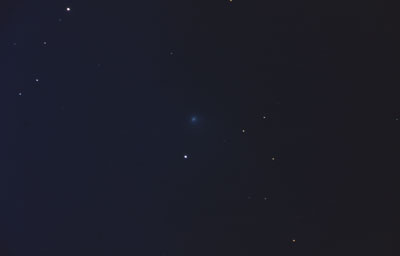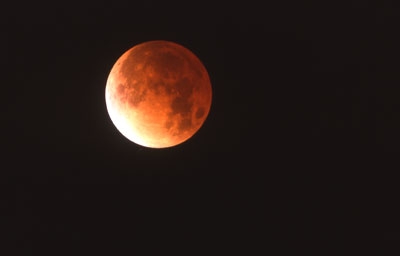One of the most common questions asked by every beginner in astronomy is: Which telescope should I buy? At least in public observatories or local astronomy clubs, the answer is almost always: Do you already have a pair of binoculars?

Although binoculars are relatively inexpensive and can be found in many households, not many people think of them as a tool for observing the sky. Instead, most are fixed on buying a very large telescope – and expect wonders from these expensive devices. The view through a large telescope can give a very impressive glimpse at the universe, but it is nothing at all like the beautiful images which we all know from astronomy magazines, newspapers and illustrated books. These images are the result of long exposure times and were captured by very experienced amateurs. The camera was often locked on an object for many hours and attached to equipment that is in the five digit dollar area. However, the eye can collect light only for about a twentieth of a second. It is therefore almost impossible to see colors even in the largest telescopes. There are usually only faint hues of color, or none at all. But everybody knows these pretty pictures, so the first look through a telescope at a deep-sky object is usually disappointing – even the most famous objects which experienced observers perceive as striking and rich in detail are only a faint nebula in the eyes of a beginner.
However, observing is an art that can be learned – practice makes perfect. But if the first view is through a low cost department store telescope with a shaky mount, using the highest magnification (which shows an almost black image), then the telescope moves very quickly to the closet or attic. But, also perfect and correspondingly expensive telescopes that may even have a computer control cannot guarantee success. Even in these scopes many objects are anything but flashy, even if the telescope will move to them error-free. If you rely entirely on the computer and do not know where an object is located in the sky, you will find it hard to know if you really have the desired object in the field – or whether it is located just outside of the small field of view.

The narrow field of view is the biggest drawback of many telescopes. Some of the most beautiful objects – be it our neighboring galaxy (the famous Andromeda Nebula M31), a splendid star cluster like the Pleiades, a gaseous nebula such as the North America Nebula, or even a bright comet – are simply too large to be fully visible in a telescope. If you also make the mistake of increasing magnification, they will become totally unobservable – the high magnification darkens the image, and the great advantage of the telescope (its ability to gather more light than the naked eye) is lost. Therefore, telescopes are often used with low magnification, which also reduces the image errors. These include aberrations of the optics as well as the disturbances in the atmosphere that are responsible for the twinkling of stars. This air turbulence is also magnified, so in bad nights the star will jump wildly through the field of view at high magnification.
To fully exploit the potential of a telescope, you have to be familiar with the sky as well as with the characteristics of your equipment. There are many different accessories which can not only increase the telescope‘s performance, but also the cost. But, to find out which accessories are worth the money, you usually have to compare them with each other.
Anyway, the biggest disadvantage of a telescope is its size – a good telescope disperses easily in three large boxes (one for the telescope, one for the mount and one for the tripod) and a smaller case for eyepieces and accessories. These must all be carried to the observation site.
A pair of binoculars with a tripod, however, can easily be carried by one person or be stored permanently in your car.

There are several reasons why a good pair of binoculars is not only popular with experienced users, but also a good choice for beginners.
- Of course, especially for the beginner the price is not to be neglected – a good entry level binocular is available for less than 200 dollars, and the used market offers even better deals.
- A pair of binoculars is always working approximately with the optimal magnification of the device. In most binoculars, the ray of light that leaves the eyepiece is about four to seven millimeters thick – so is the size of the opening of eye‘s pupil. There is no light lost that would otherwise only illuminate the iris of your eye.
- You use both eyes for observation, so basically you get two telescopes for the same money. This enables not only more relaxed views, but you can also discern more details than with monocular vision.
- It is portable. Many observation nights are not used because the existing telescope is too big and unwieldy to use. A pair of binoculars and a matching tripod can be easily carried to wherever you want to use them, and you can also keep them, for example, in the trunk or glove compartment of your car (although you shouldn‘t store them there during hot days).
- A binocular has a large field of view. Thus, the orientation of the sky is much easier to follow than with a telescope. Besides, this is the best way to get to know the sky. Many objects are also more beautiful or discernable when observed with a large field of view.
- A binocular provides an upright image, so it can also be used for observing nature, for birding or sports – either on holidays or if you may find that astronomy is not the right hobby for you.
- The technique is low-maintenance. Telescopes are precision instruments which must be regularly serviced – Newtonian telescopes must be collimated, and mounts sometimes need new grease. Computerized Go-To telescopes need some time to get used to, and often the electronics cause more problems than they solve – although the technique has become much more reliable in the last years (as long as there is enough electricity). Also, even virtually maintenance-free lens type telescopes have their pitfalls – they enable the use of many useful accessories, so that you can invest a fortune in eyepieces and filters. With a pair of binoculars, a tripod and the correct tripod adapter you usually have everything you need – however, that‘s almost all the accessories which are available. Only a few rather high-priced binoculars allow the use of deep-sky filters, which are sometimes even included in the housing. You can easily build protective filters for solar observation without investing much money.
Even experienced amateur astronomers appreciate binoculars not only for these reasons – the prejudice „but it is only a pair of binoculars“ is wrong.

Of course, both kinds of optics have their own areas of application – a pair of binoculars is not suitable for the observation of close double stars, planets or faint objects, while a telescope is not so good for comets, large star clusters or a quick look at the sky. Nevertheless, the two complement rather than compete with each other. And despite all the impressive large telescopes, which can now be found in the amateur field, do not forget one thing – Galileo Galilei had worked with far worse optics than those used today even in the lowest cost binoculars and telescopes. Nevertheless, he did change our view of the world. Tycho Brahe, whose accurate observations provided the data for Nicolaus Copernicus’ theory of our modern heliocentric world view, observed the sky for all his life without any optical aids.
So even with binoculars you can repeat some of the key observations in astronomy. The biggest attraction in the observation, however, is to see the things yourself. It is important to know what you see – if you just want to see pretty images, you‘re better off with an illustrated book. Knowledge of small nebulae and star clusters which can be seen in binoculars has its own fascination. A small, dim spot or a small star can look boring – but if you keep in mind that you are looking at a star which may be a hundred times larger than our Sun, or that the fog is the corpse of a star or even a distant galaxy with a hundred billion suns a million light-years away, things gain a whole new dimension.
